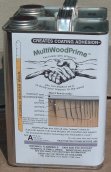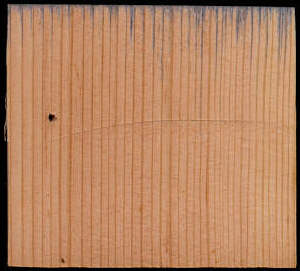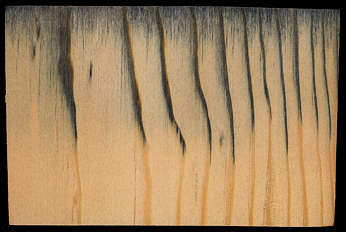

What is MultiWoodPrime™? MultiWoodPrime is a tough, flexible resin system carried into the wood by a solvent blend which dissolves the sap, oil and moisture found in wood. The resin system is derived from natural wood resin and, therefore, develops a chemical adhesive bond to the wood resin and wood fibers in the new wood. The resins from each form a bond which prevents coating adhesion failure.
The name MultiWoodPrime means what it says: it is a multi-functional primer, a claim meant to be taken by the user literally . MultiWoodPrime, in fact, performs the multiple functions of promoting topcoat adhesion, neutralizing wood acidity, sealing surface porosity, impregnating sub-surface porosity, blocking tannin bleed, resisting coating failure, and toughening up a soft surface so it can be lightly sanded.
Where did
MultiWoodPrime come from?
A secondary benefit, however, was discovered when CPES was used for wood restoration: CPES was functioning as a high grade adhesion-promoting primer as well, and the paint/stain/varnish top coatings that had been applied were not failing within the expected timeframe. Therefore, after restoration was complete, general maintenance costs were cut in half. Thus began the specification of CPES as an adhesion-promoting primer by architects and high-end contractors. Finally, word of mouth brought many a local homeowner to the manufacturer’s door, asking how and where they could buy CPES for their own home repairs. And so goes the story of how the manufacturer of an epoxy wood restoration product surveyed its customer base and found that over 60% of the product purchased was being used as a high-end primer on brand new wood! The chemist who originally formulated CPES had always known that it was a superior primer and why; he had not, however, realized that so many consumers were now using it solely as a primer on new wood. Bottom line, the feedback from state architects, millwork manufacturers, and people who had the opportunity to witness years of superior topcoat performance after CPES had been applied, led Smith & Co. to market their Clear Penetrating Epoxy Sealer as a multi-purpose-primer as well as for wood restoration. The reason: There is no primer available anywhere, not through specialty suppliers or retail outlets or any other, that functions as an adhesion promoting primer, a porosity-sealing primer, a tannin-blocking primer, an acidity-neutralizing primer and a sanding-primer, (as well as resisting long-term coating failure) all-in-one – thus the new brand name MultiWoodPrime . Why Aren’t Other Primers Effective? Because 1) the old, but still currently marketed primer formulations have not kept up with the changes effected by governmental legislation which forced topcoat manufacturers to remove key ingredients because of environmental issues, 2) no primer, old or new, was ever able to fully impregnate the porosity of old, weathered wood and new, sound wood, and 3) the quality of lumber being sold today is not the same as it was when the original primers were formulated.
Historically, a simple lead carbonate oil-based primer
[“White Lead”] worked well on slowing-growing dense old-growth wood
because
the lead carbonate also functioned as a mild, but effective, fungicide.
We all know government regulators removed the lead from all paint, but
that wasn’t all that changed. Concurrently the lumber industry
developed
fast-growing trees, and their wood was much more porous than the slow
growing types. The industry-standard euphemism for this is
“Second-growth”
lumber. (In a way, it is similar to the difference between domesticated
and wild animals; the wild ones are in many respects better-adapted to
survive.) Lastly, latex paint replaced oil-based paint, with the latex
paint manufacturers claiming their latex product could be used directly
on wood as a primer, as well as a topcoat. After these three changes
took
place, consumers found their wood rotted more easily, paint did not
prevent
rot, and when rot developed under the layer of paint, the paint
separated
from the wood.
How Does MultiWoodPrime Work? Wood impregnated with MultiWoodPrime changes the natural wood cellulose (which fungi and bacteria find tasty and easily digestible) into epoxy-impregnated cellulose, which resists attack by fungi and bacteria. The wood is also reinforced by the gluing together of the internal and surface wood fibers, while continuing to allow the wood to breathe. As a result the wood resists the natural deterioration process which leads to paint failure, especially if the paint is a waterborne product. New, “Second-growth” wood is similar to old, weathered wood in that it has a porosity which can absorb the vehicle-portion of some coatings, leaving the mineral-and-pigment-portion of the paint formula deposited on the surface as a brittle, mineral-packed layer. This film eventually cracks and the primer’s seal is broken.
MultiWoodPrime will not crack.
The reason
MultiWoodPrime will not crack is because the very thin film of epoxy
glue
on the surface continues to cure after the topcoat is applied, bonding
the top coat to the primer (and remember, the wood-derived resins in
the
MultiWoodPrime have already bonded to the natural resins in the new
wood).
In other words,
the paint becomes glued to the wood
.
MultiWoodPrime is designed to impregnate wood. Therefore it has an extremely low viscosity, meaning it runs like water. Virtually all of the product goes into the wood, gluing the fibers together. Wood absorbs more from different directions, as the following pictures show. Therefore, total immersion of the wood is optimal. In some cases immersion is not viable, such as when the individual components of the millwork have already been assembled. Surface application by brush or roller will still extend the life of the wood product by years and outperform any primer presently on the market . Spray application is discouraged because of ingredient evaporation. However, if it is necessary to spray MultiWoodPrime, the user should contact Smith & Co. A sprayable formulation is available on special order. The following are cross-sections of wood primed with MultiWoodPrime. The product is clear, but has been dyed blue to allow you to see how deeply the primer is absorbed into the wood.
Piece of modern, plantation-grown wood (note the winter growth rings
are even more porous than the summer rings).
Compare
the above to a piece of sound, old-growth Fir below.

Different woods have differing degrees of porosity, therefore, a specific quantity demand cannot be given; however, typical usages for different wood species can be estimated. For example, fir plywood such as T-111 siding may absorb an effective coverage of approximately 200 square feet per gallon. Business Profit From Using MultiWoodPrime .
Extreme end grain porosity makes wood very prone to rot due to the ease
and depth with which water may be absorbed into millwork such as doors
and windows, bath vanity cabinets and kitchen base cabinets. This can
reflect unfairly on the millwork manufacturers, the finishers, and the
top coating products specified, when in fact the real problem is caused
by the limitations of common paints/primers and the characteristics of
modern lumber. By reducing, even eliminating costly returns and field
failures in spite of having to use modern coatings on modern
“Second-growth”
lumber, business profit is increased. In some cases it may be possible
to eliminate a “primer” under a topcoat, and apply MultiWoodPrime to
the
wood and then a topcoat. This will give increased quality at the same
or even lesser cost, depending on production requirements. If a topcoat
is to be applied directly over a primer in the least production time,
an oil-base enamel topcoat will be able to be applied over
MultiWoodPrime
sooner than a latex, and with a high level of drier [curing catalyst]
in the enamel one can see handling film strength sooner than with a
latex,
whose film-forming properties depend on both temperature and humidity.
This improvement in production efficiency translates into business
profit.
A second primer, specifically an oil-based primer, is often desirable
for exterior installations or high-humidity interior applications if
using
a latex (waterborne) topcoat. The highest performing exterior coating
system would be a coat of two-part epoxy MultiWoodPrime on the bare
wood,
then an application of oil-base primer, and lastly a latex topcoat in
desired color and appearance [flat, satin, etc.].
Mix equal parts of components A and B by volume, mixing only the amount one expects to consume within the pot life (experience will allow you to estimate how fast your wood is absorbing MultiWoodPrime and/or how much coverage you are able to complete within what timeframe). Application may be by brush, roller or immersion. As previously mentioned, spraying is discouraged, but if the application must be sprayed the consumer should call Smith & Co. before ordering. Oil-base paint/stain/varnish can be applied within a few hours. When applying waterborne topcoats, it is usually wise to wait 24 hours for the solvents in MultiWoodPrime to evaporate out of the wood (if the solvents have not evaporated and the latex topcoat is applied too soon, there is a possibility of blistering). A painting contractor or homeowner can normally wait until the next day to apply the top coating. Millwork fabricators will want to work more quickly and will have to test MultiWoodPrime on the specific type of wood being used as the wood’s porosity will affect how long they need to wait before applying a topcoat. The Cold Weather Version is designed to be used in cold weather or unheated shops, where the day-to-night temperature range is low. The Warm Weather Formula is designed for higher temperature ranges and immersion-tank application. MultiWoodPrime is available in its Original Formula. and a 550 g/l VOC-Compliant formula for use in California or other areas where Wood Products Rules limit the Volatile Organic Content [VOC] of coatings. It is considered a Sanding Sealer under those rules.
The VOC-Compliant version of this product meets Wood Products Regulation
8 Rule 32 of the California Bay Area Air Quality Management District
[BAAQMD]
and corresponding Rules of other AQMDs. It meets the 550 g/l limit. All
versions are considered Sanding Sealers. If there is no AQMD category
for Sanding Sealer, it is considered a Waterproofing Sealer. |
Note: Links below are to the CPES ordering page.
The MultiWoodPrime label is no longer being produced.
Select Warm or Cold Formula at Checkout
|
MultiWoodPrime may be used with these products to assist in wood projects:
High Build Epoxy Paint/Primer ™ Email this page to a friend. |
|
The name 'MultiWoodPrime' and the statements 'Creates Coating Adhesion', 'The Primer with Integrity' and 'You can depend on it to bond your coating to the wood', all these are Trademarks and Servicemarks owned by Steve Smith and used by permission. Copyright © 2021 Steve Smith All rights reserved |
